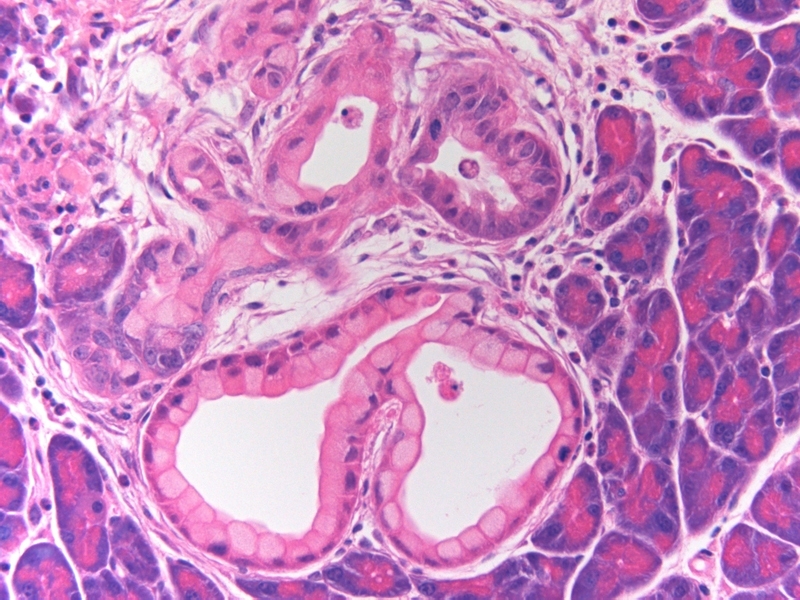Pancreatic cancer is the fourth-leading cause of cancer death in the United States, killing an estimated 35,000 Americans each year. One of the reasons pancreatic cancer is so deadly is that it is hard to detect it in the early stages, and that’s partly because scientists aren't sure from which cell(s) it arises.
Now, in findings that could help answer that question, MIT cancer biologists have identified a subpopulation of cells that can give rise to this disease. They also found that tumors can form in other, more mature pancreatic cell types, but only when they are injured or inflamed, suggesting that pancreatic cancer can arise from different types of cells depending on the circumstances.
“By the time pancreatic disease is typically diagnosed, it’s already very advanced and non-curable. Our new findings can help scientists focus their drug development efforts and lead them to new ways to detect the disease in early stages,” says Sharon Friedlander, a postdoctoral associate at the David H. Koch Institute for Integrative Cancer Research at MIT and lead author of a paper describing the work in the Nov. 3 issue of Cancer Cell.
The team, led by Koch Institute Director Tyler Jacks, found that in adult mice, tumors originate from a subpopulation of pancreatic cells that express a protein called pdx1 (but not from all cells that express pdx1). This protein plays a critical role in pancreas development and differentiation, a process of specialization that normally occurs during embryonic development but can also occur later in life. This suggests that under normal conditions, pancreatic cancer may arise from a type of adult stem cell that can differentiate into mature pancreatic cells, says Friedlander.
When the cancer-promoting gene K-ras, commonly activated in tumors, was turned on in the pdx1-expressing cells, they became cancerous. However, mature pancreatic cells, such as insulin-secreting cells, became cancerous only when they expressed K-ras and also suffered from chronic inflammation. Under these conditions, the insulin-secreting cells became another cell type, a condition that appears necessary before they can initiate pancreatic cancer.
In humans, 90 percent of pancreatic tumors express K-ras, though activation of that gene alone is not enough to cause cancer — most tumors have dozens of mutations.
Charles Murtaugh, a genetics professor at the University of Utah, who was not involved in the research, says the paper draws attention to the role of injury and inflammation in pancreatic cancer initiation. “It appears that these processes, coupled with specific changes to the genome of pre-cancer cells, are able to override normal differentiation controls to an extent not previously appreciated,” says Murtaugh, who studies the genetics of pancreatic diseases.
In future studies, the MIT researchers plan to use their mouse models to follow the molecular events that take place during pancreatic cancer development and identify potential targets for drug treatments and protein markers for early diagnosis. These new mouse models could also help researchers test potential pancreatic cancer treatments.
Now, in findings that could help answer that question, MIT cancer biologists have identified a subpopulation of cells that can give rise to this disease. They also found that tumors can form in other, more mature pancreatic cell types, but only when they are injured or inflamed, suggesting that pancreatic cancer can arise from different types of cells depending on the circumstances.
“By the time pancreatic disease is typically diagnosed, it’s already very advanced and non-curable. Our new findings can help scientists focus their drug development efforts and lead them to new ways to detect the disease in early stages,” says Sharon Friedlander, a postdoctoral associate at the David H. Koch Institute for Integrative Cancer Research at MIT and lead author of a paper describing the work in the Nov. 3 issue of Cancer Cell.
The team, led by Koch Institute Director Tyler Jacks, found that in adult mice, tumors originate from a subpopulation of pancreatic cells that express a protein called pdx1 (but not from all cells that express pdx1). This protein plays a critical role in pancreas development and differentiation, a process of specialization that normally occurs during embryonic development but can also occur later in life. This suggests that under normal conditions, pancreatic cancer may arise from a type of adult stem cell that can differentiate into mature pancreatic cells, says Friedlander.
When the cancer-promoting gene K-ras, commonly activated in tumors, was turned on in the pdx1-expressing cells, they became cancerous. However, mature pancreatic cells, such as insulin-secreting cells, became cancerous only when they expressed K-ras and also suffered from chronic inflammation. Under these conditions, the insulin-secreting cells became another cell type, a condition that appears necessary before they can initiate pancreatic cancer.
In humans, 90 percent of pancreatic tumors express K-ras, though activation of that gene alone is not enough to cause cancer — most tumors have dozens of mutations.
Charles Murtaugh, a genetics professor at the University of Utah, who was not involved in the research, says the paper draws attention to the role of injury and inflammation in pancreatic cancer initiation. “It appears that these processes, coupled with specific changes to the genome of pre-cancer cells, are able to override normal differentiation controls to an extent not previously appreciated,” says Murtaugh, who studies the genetics of pancreatic diseases.
In future studies, the MIT researchers plan to use their mouse models to follow the molecular events that take place during pancreatic cancer development and identify potential targets for drug treatments and protein markers for early diagnosis. These new mouse models could also help researchers test potential pancreatic cancer treatments.






